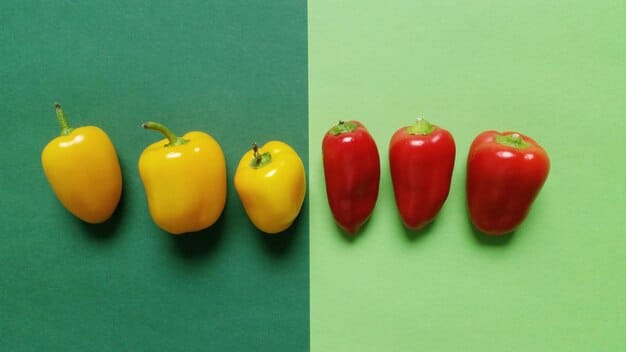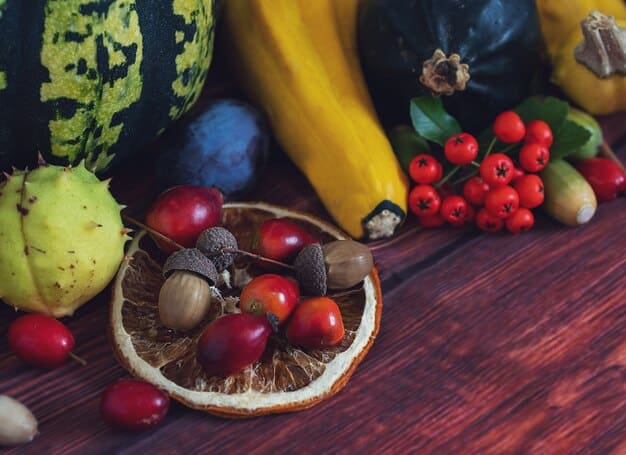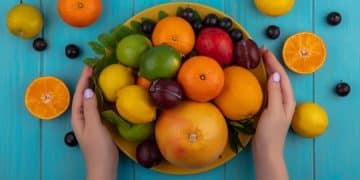Organic vs. Non-Organic 2025: Cost-Benefit Analysis Debunked

The perennial debate between organic and non-organic food intensifies in 2025, with advancements in agricultural practices and evolving economic landscapes demanding a fresh, evidence-based cost-benefit analysis for informed consumer choices.
In a world increasingly focused on health and sustainability, the choice between organic and non-organic food remains a central dilemma for many consumers. This article delves into The Truth About Organic vs. Non-Organic: A 2025 Cost-Benefit Analysis, examining the latest data, scientific perspectives, and economic realities that shape this complex decision.
Understanding Organic vs. Non-Organic: Beyond the Labels
The distinction between organic and non-organic agriculture extends far beyond simple labeling. It encompasses profound differences in farming methodologies, environmental impact, nutritional profiles, and, crucially, consumer perception and cost. In 2025, these definitions continue to evolve, influenced by technological advancements and shifting global agricultural policies.
Organic farming, as defined by stringent certification bodies, typically prohibits the use of synthetic pesticides, herbicides, GMOs, sewage sludge fertilizers, and irradiation. Instead, it emphasizes natural processes like crop rotation, composting, and biological pest control. This approach aims to foster ecological balance, conserve biodiversity, and promote soil health.
Defining Modern Organic Standards
- No Synthetic Pesticides and Fertilizers: Reliance on natural alternatives for pest management and soil enrichment.
- GMO-Free: Genetic modification is strictly prohibited in organic produce and animal feed.
- Animal Welfare: Organic livestock must have access to the outdoors and be fed organic, non-GMO feed, without the use of growth hormones or antibiotics.
- Environmental Stewardship: Practices designed to protect soil, water, and wildlife habitats.
Conversely, non-organic, or conventional farming, widely employs synthetic inputs to maximize yield and control pests and diseases. While these methods allow for efficient, large-scale production, concerns often arise regarding their potential long-term effects on human health and the environment. This does not imply a lack of regulation, as conventional farming operates under specific guidelines regarding maximum residue limits for pesticides and other chemicals.
The societal debate surrounding these two systems often overlooks the nuances. Both practices have their merits and drawbacks, contributing to a complex food system that aims to feed a growing global population. Our analysis will consider these foundational differences as we weigh the costs and benefits for the discerning consumer in 2025.
The Financial Equation: A 2025 Cost Analysis
One of the most immediate and tangible differences between organic and non-organic produce is the price tag. In 2025, this gap persists, driven by a myriad of factors inherent to the production methods. Understanding the root causes of this cost disparity is essential for consumers making budget-conscious decisions.
Organic farming methods are often more labor-intensive. Without the aid of synthetic fertilizers, pest control requires meticulous management, crop rotation, and manual weeding. This increased human effort translates directly into higher production costs. Furthermore, organic certification itself incurs significant expenses, including annual fees, inspections, and compliance audits, which are ultimately passed on to the consumer.
Key Cost Drivers of Organic Produce
- Labor Intensity: Manual weeding and pest control increase operational expenses.
- Lower Yields: Organic farming often produces lower yields per acre, requiring more land for the same output.
- Distribution and Storage: Smaller, specialized supply chains for organic products can lead to higher transportation and handling costs.
- Certification and Compliance: The rigorous process of becoming and remaining certified organic adds to the overhead.
While the upfront cost of organic food is generally higher, it is crucial to consider the broader economic implications. Investments in organic agriculture can potentially lead to long-term savings through reduced environmental remediation costs, improved public health outcomes, and sustained ecosystem services. However, these macroeconomic benefits are not directly reflected in the individual consumer’s grocery bill.
For the average household, purchasing exclusively organic food can significantly inflate weekly expenditures. This economic barrier is a primary reason many consumers, despite their environmental or health concerns, opt for more affordable non-organic alternatives. The challenge for 2025 lies in finding a balance where sustainable food choices become more accessible to a wider demographic.
Nutritional Nuances: Are Organic Foods Superior?
The belief that organic foods are inherently more nutritious is a powerful motivator for many consumers. Yet, the scientific consensus on this remains complex and, at times, contradictory. In 2025, advanced analytical techniques continue to scrutinize the nutritional profiles of organic versus conventionally grown produce.
Studies have explored differences in vitamin, mineral, antioxidant, and phytonutrient content. While some research suggests marginally higher levels of certain nutrients, such as antioxidants, in organic crops, these differences are often not large enough to be considered nutritionally significant over a balanced diet. The variation in nutrient content is influenced by numerous factors, including soil quality, climate, crop variety, and ripeness at harvest, often more so than by organic or conventional farming practices alone.

Conversely, a key concern with non-organic produce centers on pesticide residues. While levels in conventional produce are generally below the safe limits set by regulatory bodies, the long-term effects of cumulative exposure to multiple pesticide residues, particularly in vulnerable populations, remain a subject of ongoing debate and research. Organic farming largely eliminates this concern, offering peace of mind to consumers wary of chemical inputs.
The true nutritional value derived from any food comes from its overall dietary context. A diet rich in a variety of fruits, vegetables, whole grains, and lean proteins, whether organic or conventional, will always outperform a diet lacking diversity, regardless of farming method. The emphasis should perhaps be less on the “organic vs. non-organic” label and more on increasing overall consumption of nutrient-dense foods.
In 2025, consumers are encouraged to prioritize a diet abundant in fresh produce, irrespective of its organic certification, while remaining mindful of their personal comfort level regarding pesticide exposure.
Environmental Footprint: A Sustainable Standpoint
The environmental impact of food production is a critical component of any comprehensive cost-benefit analysis. Organic farming is often championed as the more environmentally friendly option, and in many respects, this holds true. However, a nuanced understanding reveals that conventional agriculture is also making strides in sustainability, and neither system is entirely without its environmental challenges.
Organic practices generally promote greater biodiversity by avoiding synthetic pesticides that can harm non-target species like pollinators and beneficial insects. They also prioritize soil health, which plays a crucial role in carbon sequestration and water retention, potentially mitigating the effects of climate change and reducing soil erosion. The absence of synthetic nitrogen fertilizers in organic farming reduces nitrous oxide emissions, a potent greenhouse gas.
Environmental Benefits of Organic Agriculture
- Enhanced Biodiversity: Supports a wider range of plant and animal life by avoiding harmful chemicals.
- Improved Soil Health: Promotes natural soil fertility and structure, boosting carbon absorption.
- Reduced Chemical Runoff: Minimizes water pollution from synthetic inputs.
- Lower Energy Consumption: Less reliance on synthetic fertilizers, which are energy-intensive to produce.
However, organic farming can sometimes require more land to produce the same amount of food due to lower yields, potentially leading to increased deforestation if not managed carefully. The transportation of organic goods, often from smaller, more dispersed farms, can also contribute to carbon emissions, depending on the supply chain efficiency.
Conventional agriculture, while historically associated with higher chemical use, is also evolving. Precision farming techniques, genetically modified crops designed for resilience, and improved water management systems are reducing its environmental footprint. The sheer efficiency of conventional methods in terms of yield per acre can also be seen as an environmental benefit, as it limits the need for extensive land conversion.
Ultimately, the environmental impact is highly context-dependent. Local sourcing, regardless of organic status, can often have a lower carbon footprint than organic produce shipped over long distances. Consumers in 2025 are increasingly considering the entire lifecycle of their food, from farm to fork, when evaluating environmental responsibility.
Health Implications: Pesticides, Hormones, and Gut Health
Beyond nutritional content, consumers often weigh the potential health implications of pesticide residues and the use of hormones and antibiotics in conventional animal agriculture. This remains a significant area of concern for many, influencing their purchasing decisions in 2025.
Pesticide exposure is a primary driver for choosing organic produce. While regulatory bodies establish maximum residue limits (MRLs) for conventional crops, ensuring levels are generally safe for consumption, some individuals remain concerned about chronic, low-level exposure, particularly for children and pregnant women. Organic farming bypasses this concern by eschewing synthetic pesticides, though natural pesticides are permitted and used. Research into the long-term effects of diverse pesticide exposures is ongoing, contributing to the continued appeal of organic options for those seeking to minimize chemical intake.
Considerations for Health-Conscious Consumers
- Pesticide Residues: Organic generally means minimal or no synthetic pesticide residues.
- Antibiotic Resistance: Organic livestock practices restrict antibiotic use, potentially mitigating concerns about antibiotic resistance in humans.
- Hormone Use: Organic standards prohibit growth hormones in livestock, addressing related health concerns.
- Gut Microbiome: Some research suggests a diverse diet, potentially linked to organic practices, could benefit gut health.
In animal agriculture, organic standards prohibit the use of growth hormones and the routine use of antibiotics. This addresses consumer fears regarding hormone ingestion and the growing global issue of antibiotic resistance. Conventional animal farming, while often more cost-effective due to these allowances, faces scrutiny for its contribution to antibiotic-resistant bacteria, which poses a serious public health threat.

Furthermore, emerging research is exploring the connection between agricultural practices and human gut health. Some preliminary studies suggest that a diet rich in organic foods, which may contain a more diverse microbial community due to farming practices that support soil biodiversity, could positively influence the human microbiome. However, this field is still nascent, and more definitive conclusions require extensive research.
For individuals with specific health concerns, or those simply preferring to minimize their dietary exposure to synthetic chemicals, the health-related benefits of organic food present a compelling argument, even if the nutritional differences aren’t always profound. It often comes down to personal risk assessment and peace of mind.
Consumer Choices in 2025: Navigating the Market
In 2025, navigating the grocery aisles to make informed decisions about organic versus non-organic food is more complex than ever. Consumers are faced with a growing array of choices, influenced by marketing, personal values, and budget constraints. Understanding how to prioritize purchases and recognize credible information is key.
One strategy is to consider the “Dirty Dozen” and “Clean Fifteen” lists, updated annually by organizations like the Environmental Working Group (EWG). These lists highlight produce most and least likely to contain pesticide residues, guiding consumers on where buying organic might have the most significant impact on reducing chemical exposure. For instance, berries and spinach often appear on the “Dirty Dozen,” while avocados and sweet corn are typically among the “Clean Fifteen.”
Another important aspect is local sourcing. Purchasing from local farms, whether they are certified organic or not, can offer significant benefits. Local produce is often fresher, leading to better taste and potentially higher nutrient retention. It also reduces transportation costs and emissions. Many conventional local farms utilize sustainable practices even if they don’t pursue costly organic certification.
Ultimately, the choice comes down to personal priorities. For some, the environmental benefits and peace of mind regarding chemical exposure justify the higher cost of organic. For others, affordability and the ability to consume a large volume of fruits and vegetables, regardless of farming method, take precedence. The market in 2025 offers solutions for both perspectives.
Educating oneself about specific farming practices, understanding certification labels, and prioritizing a balanced diet are more crucial than ever. The goal is to make choices that align with individual health goals, financial realities, and environmental convictions, contributing to a more sustainable and equitable food system for all.
The Future Landscape: Innovations and Integrations
The debate between organic and non-organic farming is not static; it is a dynamic landscape continuously shaped by innovation, evolving consumer demands, and pressing global challenges. In 2025, the future of food production promises exciting developments that may bridge the historical divides between these two approaches.
Research into sustainable conventional farming practices is accelerating. Precision agriculture, using data and technology to optimize resource use, is becoming more widespread, allowing conventional farms to reduce water, fertilizer, and pesticide application. Robotics and AI are enhancing efficiency, minimizing waste across the supply chain, and even enabling forms of indoor vertical farming that can significantly reduce land and water use, regardless of organic certification.
Emerging Trends in Sustainable Agriculture
- Precision Agriculture: Data-driven optimization of resource use in conventional farming.
- Vertical Farming: Controlled-environment agriculture reducing land and water footprint.
- Biodynamic Farming: Holistic, ecological, and ethical approach, extending beyond organic.
- Agroecology: Integrating ecological principles into food production systems for sustainability.
Simultaneously, the organic movement is also embracing new technologies for better farm management, improved pest control, and enhanced yields, all within the strictures of organic principles. The concept of “regenerative agriculture,” which goes beyond sustainability to actively improve ecosystems, is gaining traction, integrating best practices from both organic and conventional thinking to restore soil health and biodiversity on a larger scale.
The challenge for 2025 and beyond is not necessarily to choose one system over the other, but to integrate the best practices from both. A hybrid approach that reduces reliance on synthetic chemicals, promotes soil health, conserves water, and ensures fair labor practices, while also producing sufficient nutritious food affordably, is the ideal. This shift requires continued research, supportive policies, and an informed consumer base willing to invest in such a future.
Ultimately, the goal is a food system that is resilient, equitable, and capable of nourishing a growing global population without depleting the planet’s resources. The conversation about organic versus non-organic will continue, but it is moving towards a more collaborative and innovative approach to sustainable food production.
| Key Point | Brief Description |
|---|---|
| 💰 Cost Difference | Organic foods often cost more due to labor, lower yields, and certification. |
| 🌱 Nutritional Value | Minor differences, with overall diet diversity more crucial than organic status. |
| 🌳 Environmental Impact | Organic offers benefits like biodiversity and soil health; conventional improving with technology. |
| 🍎 Health Concerns | Organic minimizes synthetic pesticide/hormone exposure; focus on overall diet. |
Frequently Asked Questions About Organic vs. Non-Organic
While some studies suggest marginally higher levels of certain nutrients like antioxidants in organic produce, these differences are often minor and not nutritionally significant. Factors like soil quality, climate, and variety typically influence nutrient content more than farming method alone. A balanced diet of diverse foods is most important.
Organic food tends to be pricier due to more labor-intensive farming methods, stricter regulations, lower yields per acre, and the costs associated with organic certification and compliance. These increased production expenses are usually passed on to the consumer, reflecting the additional effort and resources involved.
Yes, organic farming prohibits the use of synthetic pesticides. While conventional produce usually has pesticide residues within safe limits set by regulations, choosing organic significantly minimizes your dietary exposure to these chemicals, offering peace of mind to consumers concerned about chemical intake.
Organic farming typically supports biodiversity, soil health, and reduces chemical runoff. Conventional farming can be highly efficient in land use, and new technologies are making it more sustainable. The environmental impact depends on numerous factors, including specific practices, location, and transportation.
Not necessarily. Focus on a balanced diet rich in fruits and vegetables, regardless of whether they’re organic. Prioritize organic for items on the “Dirty Dozen” list if concerned about pesticides. Otherwise, conventional produce still offers significant nutritional benefits within a budget.
The Informed Choice: Navigating Your Plate
The journey through the organic versus non-organic debate reveals a complex tapestry of economic, environmental, nutritional, and health considerations. In 2025, the truth is not a simple binary choice but a nuanced understanding that empowers consumers to make informed decisions tailored to their individual priorities. While organic food undeniably offers benefits in terms of reduced synthetic chemical exposure and often contributes to more sustainable farming practices, it comes at a higher financial cost. Conversely, conventional agriculture continues to innovate, providing affordable, abundant, and increasingly sustainable options. The ultimate cost-benefit analysis hinges on personal values, financial capacity, and a commitment to a diet rich in whole foods, regardless of their farming origin. Looking ahead, the integration of best practices from both worlds promises a more resilient and nourishing food future for all.





